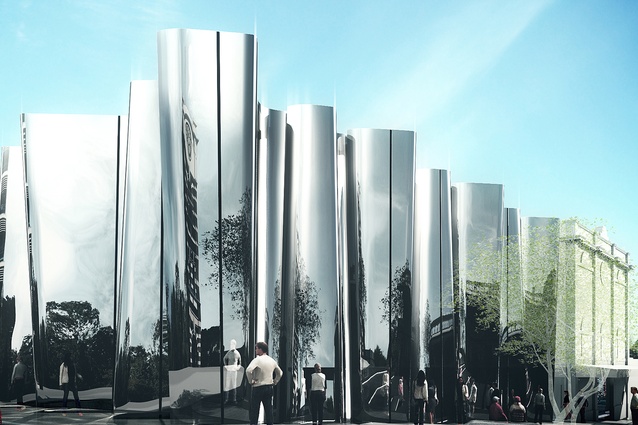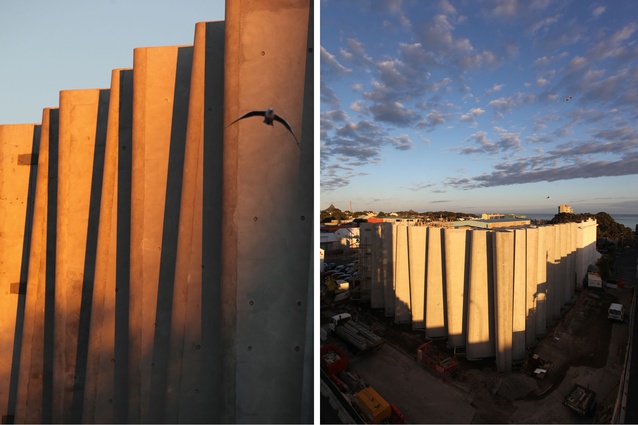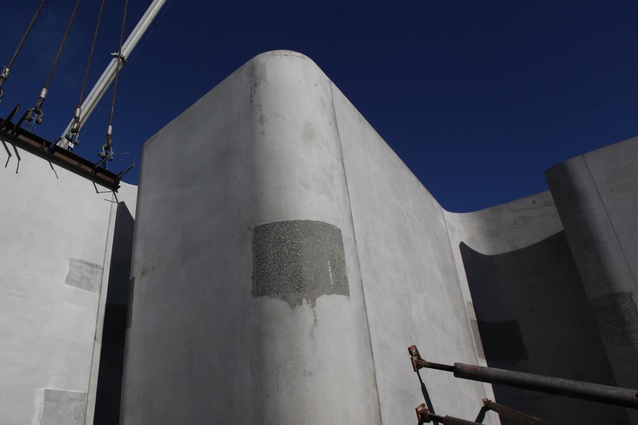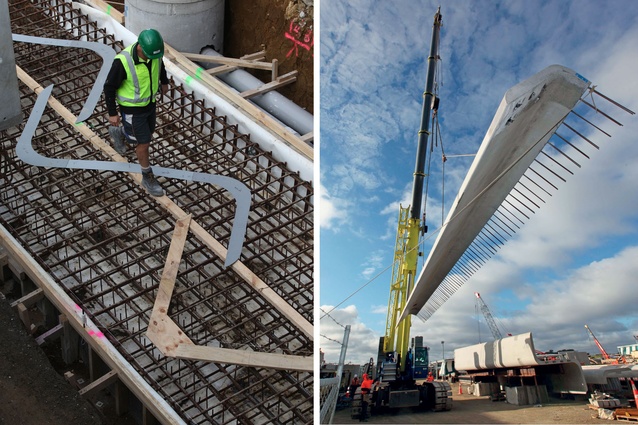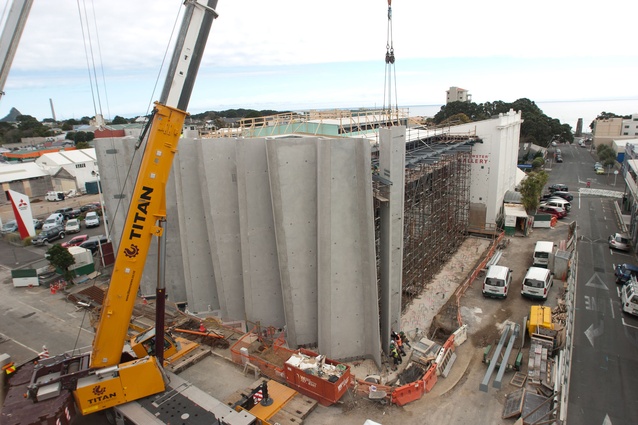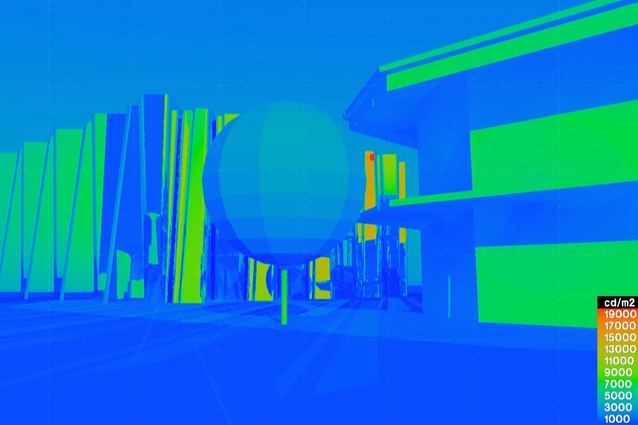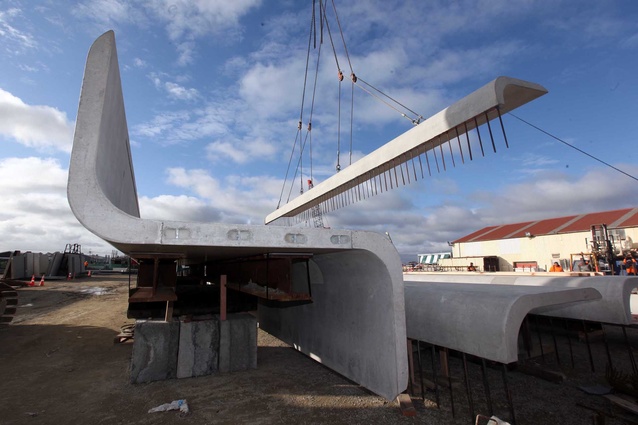The art of building
The Len Lye Centre in New Plymouth is a unique building designed to house the work of a remarkable New Zealand artist. The building, which adjoins and is a combined facility with the Govett-Brewster Gallery, will be a striking presence among others from different historical times - the neighbouring White Hart Hotel (1886), the clock tower (originally 1907, rebuilt 1985), and the modernist Atkinson Building (1950).
Len Lye (1901-1980) is renowned worldwide for his kinetic sculptures and is arguably the first artist to sculpt using stainless steel. Taranaki has a strong steel manufacturing industry, and local company Rivet fabricated the stainless steel components of the centre’s façade.
The movement, play and patterns of light, characteristic of Lye’s sculptures inspired the design by Patterson Associates Architects. The design is notable for the 32-tonne stainless steel “wave” cladding on the concrete south and east colonnade façades, which has been used to produce an aesthetic effect on the street below.
Harnessing the reflectivity was a central component of the design, Patterson Associates Architects director Andrew Patterson says. The design team used sophisticated computer simulation and modeling to predict, and then to modify, these characteristics to create a moving kaleidoscopic light display on the pavement.
“The patterns of light that Len Lye used in his work are intended to fill the public space around the building,” says Andrew Mitchell, the building’s project director.
The public area around the building will be strategically planted to filter the light effect to passing motorists. The position and size of the planting was generated by Ecotect, and modeling geometry by Autodesk.
“It’s a complex science and the predictive work has been at the forefront of available computer technology”, Mitchell says. “We’re not sure this technology was around for other stainless steel buildings like the Los Angeles Disney Centre designed by Frank Gehry,” Mitchell says.
“Generally, these effects in buildings are unintended. As far as we know the architectural use of reflections as a deliberate strategy is unique.”
The technology is used in conjunction with the more old fashioned insitu testing of glare and dulling down where needed during the handover period.
The centre comprises two galleries – a nine-metre-high, floor-to-ceiling large works gallery and a six-metre-high main gallery, accessed by a sweeping, curved ramp that will serve as additional gallery space. The large works gallery will house works built to a scale Lye aspired to but lacked the capability to make.
A motor room under the large works gallery will house any floor-based motors needed for the kinetic artworks.
The centre will also hold Lye’s film works, painting, drawing, photography, batik and writing. There are two education spaces, a dedicated Len Lye archive, and a multipurpose 60-seat cinema.
A light well provides natural light for the education spaces and ambient light also shines through 30 glazed vertical slots with motorized shutters between the colonnade panels. The shutters will allow the gallery to produce a range of different light conditions and effects within the building.
A glass lift, donated by John Matthew, chairman of the Len Lye Foundation and long time friend of Lye, will give the public a different viewing perspective.
The construction of the façade is a first for contractors, Clelands Construction. “It’s one of a kind in New Zealand - something we have never encountered before and are unlikely to encounter again,” says Clelands Construction project manager, Bruce Earby.
The 14-metre-high colonnade ‘waves’ are made in three parts (the two opposite wings and the central part of the wave) by Emmetts Civil Construction.
“They make the opposite wings and they are set on a separate bed and joined together to make one panel,” Earby says. “The joins will be wrapped in stainless steel. Emmett used formers they could detach when the precast got an initial set then they hand finished them to get the curves right.”
The construction philosophy was built around staging. The cinema required a deep foundation excavation and there were some very large panels on one of the boundary walls.
“To be able to erect the panels, we had to build up from the base of the theatre and get to a stage where we could back-fill around that and start erecting some of the bigger walls before we moved out too far. A lot of thought went into the staging from a construction point of view. There was nowhere to put a tower crane, it wouldn’t have reached or lifted half the panels.”
The boundary panels are 14 metres high by approximately three metres wide and 150mm thick. The façade panels are 14 metres high, weigh 35 tonnes each and were lifted into place with a 350 tonne taxi crane. “They are big animals – there were only three trucks available that were the right size and configuration to carry panels of that size [at one panel per truck]. There is quite a bit of work in rotating them off the truck to get them standing vertical before we erect them.”
The site is on the main road close to the central business district, which also posed constraints. The contractors took over half the road on both faces of the building to crane in the pre-cast panels and allow truck movements. The crane took half a day to set up and it takes about three-and-a-half hours to lift, place and fix a panel. The team averaged between three and five panels in a three-day period. There were 22 panels in all.
The project attracted intense public interest and hoardings were pushed out to keep the public safe.
“We had a lot of people watching. Even the crane operators hadn’t rotated a panel like that before. We found out which processes worked best and got more confident and a lot faster. There have been no issues so far.”
The well-finished, pre-cast concrete is exposed on the inside of the building. There are layers on the outside of the panels comprised of waterproofing then insulation and finally the steel rain screen that is hung from the top with sliding connections all the way down. As the sun strikes the steel it expands and contracts, moving up and down the face. Façade engineers Mott MacDonald engineered the rain-screen.
Structurally, the Len Lye Centre is a very large, heavy structural steel building built to hold large, heavy works of art.
“The design of the structural steel meant there were some very heavy casting plates that were part of the precast central core as well. All that had to be set within millimetres so the structural steel could fit exactly where it had to go. And it has. Both the pre-caster and the guys on site have done a really good job. Nothing has had to be cut, redrilled or refixed – it fitted perfectly within the tolerances of 3mm to 5mm,” Earby says.
Fixings are also solid to support the artwork and power is available for flexible display of the works at many points around the galleries.
“They can suspend a car if they want to.” And a hatch, six metres long by 3.5 metres wide, in the middle of the roof will allow large items to be craned into the gallery.
The seismic upgrade of the main Govett-Brewster Gallery by Holmes Consulting is another part of the project. The gallery was confirmed as an earthquake-prone building with an assessed strength of less than 20 per cent of the New Zealand Building Code. Huge horizontal lattice roof trusses were installed along with concrete shear walls.
When complete, the combined Len Lye Centre and Govett-Brewster Art Gallery will make a significant contribution to the art galleries of the world.
The project, budgeted at approximately $17 million, began in April 2013 and will be complete next year ahead of opening in mid 2015.

